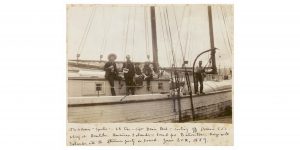Moreover, his formal choices – blending the epic into his ballad – helped to make “Song of Rahéro” a unique work in Stevenson’s Pacific oeuvre, as it depicts characters radically unlike the Tahitians portrayed in texts associated with evolutionary anthropology. Stevenson’s “Song of Rahéro” features confusing transitions and awkward phrasing, but, as Walter Benjamin has argued, even “bad” translations may adapt “meaning” well. An understanding of the form and composition of this under-studied work can shed new light on Stevenson’s conception of, and translation of, the South Pacific.
Intriguingly, the paratexts to “Song of Rahéro” undermine the politics of the text that they frame. While “Song of Rahéro” represents strong Tahitian characters, the preface and annotations position Stevenson as one more capable of sophisticated analysis than his sources.
Image: Robert Louis Stevenson (second from left) aboard the schooner "Equator" at Honolulu, Hawaii, 1889. Photo held at the Writer's Museum, Edinburgh. View other photographs in this collection.
